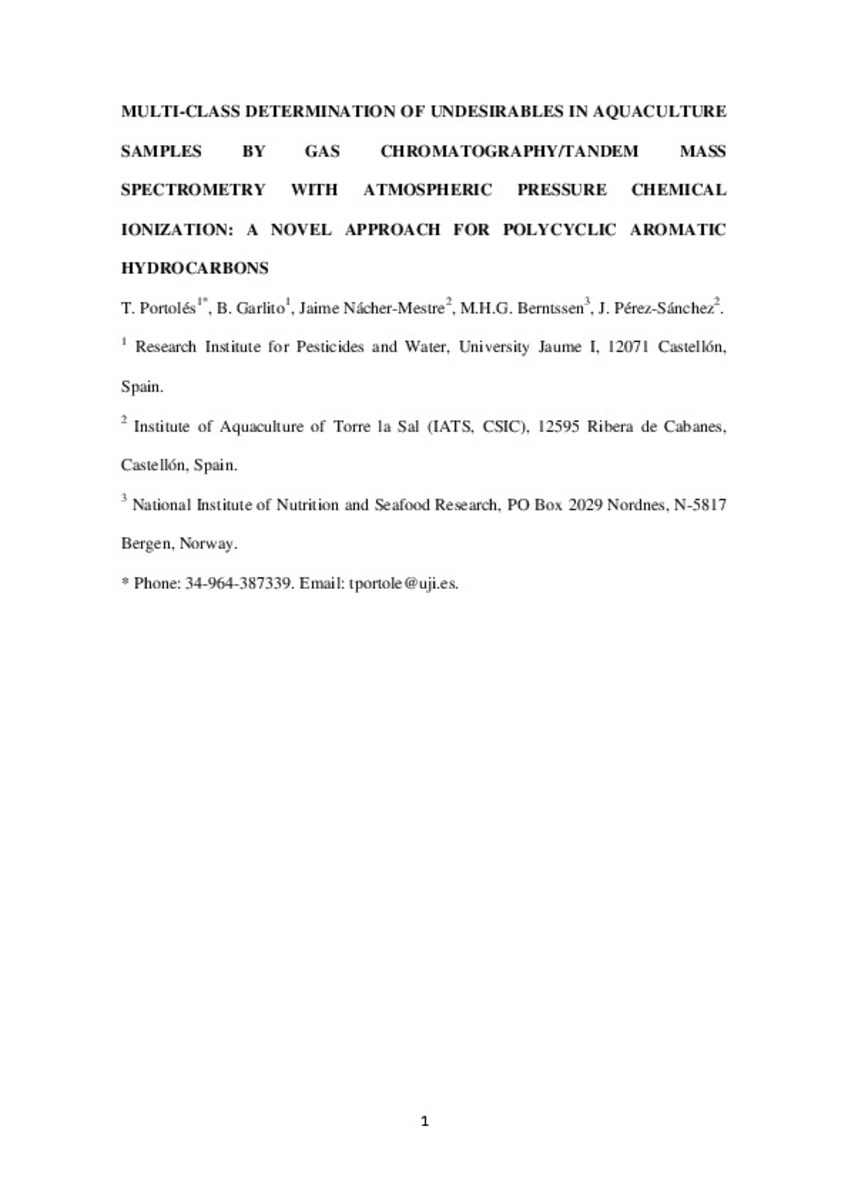Mostrar el registro sencillo del ítem
Multi-class determination of undesirables in aquaculture samples by gas chromatography/tandem mass spectrometry with atmospheric pressure chemical ionization: A novel approach for polycyclic aromatic hydrocarbons
| dc.contributor.author | Portoles, Tania | |
| dc.contributor.author | Garlito Molina, Borja | |
| dc.contributor.author | Nácher Mestre, Jaime | |
| dc.contributor.author | Berntssen, Marc H. G. | |
| dc.contributor.author | Pérez Sánchez, Jaume | |
| dc.date.accessioned | 2018-01-16T15:41:21Z | |
| dc.date.available | 2018-01-16T15:41:21Z | |
| dc.date.issued | 2017 | |
| dc.identifier.citation | Portolés, T., Garlito, B., Nácher-Mestre, J., Berntssen, M. H. G., & Pérez-Sánchez, J. (2017). Multi-class determination of undesirables in aquaculture samples by gas chromatography/tandem mass spectrometry with atmospheric pressure chemical ionization: A novel approach for polycyclic aromatic hydrocarbons. Talanta, 172, 109-119. | ca_CA |
| dc.identifier.issn | 0039-9140 | |
| dc.identifier.issn | 1873-3573 | |
| dc.identifier.uri | http://hdl.handle.net/10234/171887 | |
| dc.description.abstract | In this work, a method for the analysis of 24 PAHs in 19 different matrices, including fish tissues, feeds and feed ingredients, has been developed using gas chromatography coupled to triple quadrupole tandem mass spectrometry with atmospheric pressure chemical ionization source (GC-APCI-MS/MS). The method is based on a modification of the unbuffered QuEChERS method, using freezing as an additional clean-up step and applying a 20-fold dilution factor to the final extract. The procedure was also tested for 15 pesticides and 7 polychlorinated biphenyl (PCB) congeners in order to widen the scope of the method. The excellent sensitivity and selectivity provided by GC-APCI-MS/MS allowed the dilution of the sample extracts and quantification using calibration with standards in solvent for all the 19 matrices tested. The developed method was evaluated at 2, 5 and 50 ng·g-1 spiking levels. LOQs were 2 ng·g-1 for most compounds, and LODs ranged from 0.5 to 2 ng·g-1. Analysis of real-world samples revealed the presence of naphthalene, fluorene, phenanthrene, fluoranthene and pyrene at concentration levels ranging from 4.8 to 187 ng·g-1. No PCBs, DDTs and pesticides were found in fillets from salmon and sea bream. | ca_CA |
| dc.format.extent | 34 p. | ca_CA |
| dc.format.mimetype | application/pdf | ca_CA |
| dc.language.iso | eng | ca_CA |
| dc.publisher | Elsevier | ca_CA |
| dc.relation.isPartOf | Talanta, 2017, vol. 172, p. 109-119. | ca_CA |
| dc.rights.uri | http://rightsstatements.org/vocab/CNE/1.0/ | * |
| dc.subject | polycyclic aromatic hydrocarbons | ca_CA |
| dc.subject | atmospheric pressure chemical ionization | ca_CA |
| dc.subject | gas chromatography | ca_CA |
| dc.subject | triple quadrupole | ca_CA |
| dc.subject | aquaculture | ca_CA |
| dc.subject | fish | ca_CA |
| dc.subject | feed | ca_CA |
| dc.title | Multi-class determination of undesirables in aquaculture samples by gas chromatography/tandem mass spectrometry with atmospheric pressure chemical ionization: A novel approach for polycyclic aromatic hydrocarbons | ca_CA |
| dc.type | info:eu-repo/semantics/article | ca_CA |
| dc.identifier.doi | https://doi.org/10.1016/j.talanta.2017.05.025 | |
| dc.relation.projectID | This work has been funded by the EU Seventh Framework Programme ARRAINA Project 288925 (Advanced Research Initiatives for Nutrition and Aquaculture), and the 21 Norwegian Research Council SAFETY-PAP project (227387) from the Sustainable Innovation in Food and Bio-based Industries (Bionær) program. Additional funding was obtained from Generalitat Valenciana (research group of excellence PROMETEOII/2014/085; PROMETEOII/2014/023; ISIC 2012/016). This work has been developed within the framework of the Research Unit of Marine Ecotoxicology (IATS (CSIC)-IUPA (UJI)). We also thank the Spanish Ministry of Economy and Competitiveness and European funding from FEDER program (project AGL2012- 37201). | ca_CA |
| dc.rights.accessRights | info:eu-repo/semantics/openAccess | ca_CA |
| dc.relation.publisherVersion | https://www.sciencedirect.com/science/article/pii/S0039914017305428 | ca_CA |
| dc.type.version | info:eu-repo/semantics/submittedVersion | ca_CA |
Ficheros en el ítem
Este ítem aparece en la(s) siguiente(s) colección(ones)
-
QFA_Articles [812]
Articles de publicacions periòdiques







